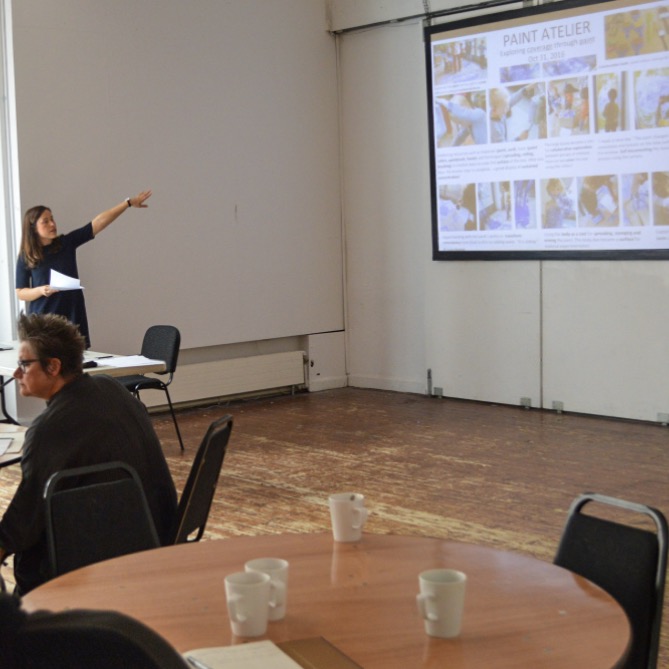This post reports on the ‘Space, materials, the body: Researching young children’s experiences in museums’ symposium held at Manchester Metropolitan University on May 23, 2017.

I almost did not write this post. I didn’t have the mental capacity to do it immediately after the event and now several months have gone by and it seems outdated. However, the ‘Space, materials, the body: Researching young children’s experiences in museums’ had quite an impact on me. I want to write about it because it I felt like the ideas that were discussed made a real contribution to the possibilities of early childhood education in museums.
The symposium aimed to bring together researchers and practitioners working with young children in museums. Key questions explored throughout the sessions included:
- How can we conceptualise child in museums differently?
- How can we think about the material, spatial and bodily nature of very young children as they explore and move through museum spaces?
- What are the implications of this for museum provision (such as programming and interpretation), and what does research need to look at next?
The event was coincidentally held the day after the Manchester terrorist attack and the weight of this unexpected tragedy could be felt in the room. Manchester holds a special place in my heart. I absolutely loved the three months that I lived there in 2016. The mix of the industrial buildings and vibrant artistic communities reminded me much of my hometown of Melbourne, Australia.
Abi Hackett, Christina MacRae and Lisa Procter presented a keynote paper on the topic of ‘Vibrancy, repetition, movement: Reconceptualising young children in museums.’ The presentation drew on post-humanist theory to re-frame how we interpret children’s learning in museums. I was particularly interested to hear how the team described museum objects as ‘entanglements’ of the human and non-human worlds. Drawing on data from various research projects, the team also discussed aspects of human experiences that were difficult to rationalize or capture in words. These ‘non-representations’ add to the complexity of museum programming and construct new ways of thinking about children’s meaning-making experiences.
I enjoyed Rachel Holmes and Christina MacRae’s workshop on de-centering children as the sole locus of meaning-making in museums. The session used data collected from the Clore interactive studio at Manchester City Art Gallery to explore three different constructions of childhood: the cognitive child, the socio-constructivist child and the post-human child. As a group we analysed and interpreted the data through these different lenses and discussed the limitations and possibilities of each construction. A convincing point was made in relation to the necessity to think beyond one’s discipline when interpreting data and developing programming.
I unfortunately missed Andrew Stevenson’s presentation on ‘sound walking as a method’ as a result of our presentations being run in parallel. I was disappointed as on first reading the abstract, ‘sound walking’ sounded suspiciously like something one may have thought up whilst taking acid at Burning Man. On second reading it also sounded like an interesting, left-of-centre methodology to explore non-verbal ways of experiencing museums.
I gave a talk on pedagogical documentation as a tool for learning and change while curating children’s activities in art museum. The presentation reported on a 13-week action research project that introduced pedagogical documentation – a process that seeks to make children’s and adult’s learning visible – to the early year’s Atelier programme at the Whitworth, University of Manchester. Key findings from the research suggest that pedagogical documentation can be made specific to gallery learning and used to record a wide array of children’s and family’s experiences. These observations can then be used to generate collaborative critical reflection that can then be used to inform future programme planning. The research also indicated that pedagogical documentation is useful in supporting gallery team’s reconsideration of assumptions, ethics and practices towards children in art museums. This then allows for practices to become more complex, for that complexity to be made visible and therefore open to interpretation from others. This process can be used to support the emergence of alternate pedagogies that are constructed from within a specific social, political, cultural and temporal context. Any die-hard pedagogical documentation fans can read the full abstract here.
I also attended Laura Trafi Prat’s practical workshop on ‘drawing as a method of inquiry’ that explored this artistic process as a means of encountering museums in a more embodied and material way. As a group we created a series of unfinished abstract drawings that were ‘responsive to life as movement, change and flow’ (taken from the workshop abstract).
Overall, I felt the event really pushed the boundaries of how academics and practitioners think about young children in museums. Constructivist learning theory has dominated museum education and this framework offers a unique possibility to expand on that. A challenge that researchers, including me, may face in drawing upon post-humanist constructions of childhood is around how these ideas are put into a simple, concise and useful form that non-academics can then incorporate into their everyday practices with children in different museum contexts.
Abi Hackett has also setup a new ‘Under 5’s in Museums’ website that includes extended outlines of the presenter’s abstracts from the event as well as updates on museum related research projects from the Education and Social Research Institute at Manchester Metropolitan University.




